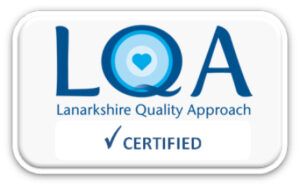Healthy Eating for Children
Information for patients
NHS Lanarkshire Dietetic Department
PIL.HLTHEAT.16707.L
Healthy eating for children
Children need to eat a variety of different foods to get all the energy and nutrients they need to grow. But all too often, children eat too much ‘junk’ food, often despite the best efforts of parents. The aim of this leaflet is to help your child and all the family start to eat more healthily.
What are Healthy Foods?
The nutrients children need are found in four important food groups – offer them everyday.
1. Carbohydrate Group
This includes bread, potatoes, breakfast cereals, pasta, rice and noodles. These foods provide the body with the energy to be active during the day, imagine them as the body’s fuel supply. They also contain fibre, especially wholegrain varieties. Base each meal on bread, potatoes, rice, pasta or breakfast cereal. Include scones, pancakes, crumpets and cereal bars as snacks.
2. Fruit and Vegetables
Fruit and vegetables contain fibre and also many vitamins and minerals. Fresh, frozen, dried and canned fruit and vegetables all count. Try to encourage your child and family to eat 5 portions each day. A child’s portion size for fruit & veg will fit in the palm of their hand.
A portion is:
- An apple, orange, banana or similarly sized fruit
- 2 plums, satsumas or similarly sized fruit
- A handful of grapes or berries
- A slice of melon, pineapple or large fruit
- 2 serving spoons of cooked vegetables e.g. carrots or broccoli
- A dessert bowl of salad
- A 150ml glass of fresh fruit juice or smoothie (only one portion per day)
- Dried fruit eg small box of raisins or 2-3 dried apricots
3. Milk, Dairy Products and Milk Substitutes
This group includes milk, cheese and yoghurt. These foods provide the body with protein, calcium and other minerals. Calcium is very important for strong bones, especially for children as they are growing. Non-dairy alternatives are suitable from 1 year eg soya, coconut, oat, almond – choose brands which are fortified with calcium and unsweetened. Make sure children have these foods two to three times a day e.g. milk as a drink or in breakfast cereal or in a pudding. Try using low fat varieties of milk and dairy foods as they have just as much calcium, protein and vitamins. Semi-skimmed milk can be given to children who eat a varied diet after their 2nd birthday.
4. Protein Group
This food group includes meat, poultry, fish, eggs, nuts and pulses. Vegetarian options meat free alternatives can also be used such as quorn or tofu. Offer these foods two or three times a day. These foods contain plenty of protein and iron which are needed to help the body grow.
5. Fats and Sugars
Foods higher in sugar and fat give extra energy but few nutrients e.g. biscuits, cake, ice cream, sweets, chocolates and savoury snacks such as crisps. These foods should only be offered in small amounts as they can easily lead to excess energy intake. Only use a little butter, margarine or oil in cooking, or on bread. Grill, steam or bake foods rather than frying them.
Top Tips for Healthy Eating
To follow the healthy eating principles, here are some tips to help your child and family:
- Eat regularly: it doesn’t help to miss out meals, breakfast is especially important.
- Drink plenty of water. Fizzy and sugary drinks can damage teeth.
- Cut down on food and drinks high in sugar e.g. sweets, chocolate, fizzy drinks, cakes and biscuits.
- Cut down on the amount of high fat foods e.g. crisps, chips and pastries. Reduce in frequency and quantity.
- Avoid fried foods e.g. fried sausage, burgers and eggs.
- Look at your weekly shopping to see what changes you can make for the whole family.
- Eat together as a family, turn off TV, tablets and put phones away to reduce distractions at mealtimes.
- Encourage the whole family involved in cooking and shopping.
Below are ideas of what your child could have for breakfast, lunch, dinner and as snacks.
Ideas for Breakfast
- Plain cereal with semi skimmed milk. Add some chopped fresh fruit to the cereal or have a glass of unsweetened fruit juice.
- Wholemeal toast, toasted muffin, crumpet with a scraping of marmite, jam, honey or low fat spread.
- Porridge or plain ready brek, with a few raisins or sultanas for sweetness.
- Overnight oats
Ideas for Lunches
Sandwiches – using different breads can add variety. Try wholemeal, granary, a bagel, crusty roll, chunk of French bread, pitta or wrap. Wherever possible, add some salad and use a thin scraping of low fat spread if required. Below are ideas for sandwich fillings:
- Cooked lean meat
- Boiled eggs with spring onion/chives/cress
- Sliced ham, chicken, turkey – you could also add a small amount of pickle or chutney
- BLT (grilled, lean bacon with lettuce and tomato)
- Mashed tinned sardines or pilchards in tomato sauce
- Tinned tuna with chopped spring onion/celery/sweetcorn
- Mashed tinned salmon with chopped cucumber
- Baked beans & toast
In addition to sandwiches offer low fat/low sugar yoghurt and fruit.
Ideas for Evening Meals
- Healthy home-made pizza
- A Jacket potato with one of the following: baked beans and a little grated cheese, chopped cooked chicken with sweet corn or cottage cheese.
- Grilled fish fingers/breaded fish portion/chicken breast/chicken drumstick (both with the skin removed)/piece of fish with Boiled new potatoes/jacket potato/mashed potato and boiled vegetables/salad/baked beans.
- Meat based dish eg chilli/spaghetti bolognaise with rice/pasta & salad.
Ideas for Snacks
- A low fat fruit yoghurt
- A small packet of dried fruit
- Plain popcorn
- A piece of fruit
- Raw vegetable sticks (carrot, cucumber, celery, sweet pepper)
- A toasted teacake, a scone or a slice of malt loaf (no butter)
- A handful of pretzels
Fluid
Children should be encouraged to drink water or milk. Fizzy drinks should be avoided. Fruit juice and smoothies contain sugar and should be diluted with water especially for children under 5 years. Offer a drink with meals and in between, more will be need in hot weather or after exercise.
Salt
Children do not need salt added to their food, use pepper, herbs & spices instead. Packet noodles, crisps and ready meals should be limited as they contain large amounts of salt.
Vitamin Supplements
All children should take a Vitamin D supplement containing 10 microgrammes.
A Healthy Lifestyle
A healthy lifestyle also includes being active on a daily basis. Current Government guidelines advise children to aim to do at least 60-minutes moderate physical activity most days. Encourage your child to be active and limit their time watching TV, playing on games consoles or playing video games. Remember children learn best by example; be a good role model by adopting healthy eating and exercise behaviours yourself.
Useful websites for recipes/meal ideas
Contact Numbers
- Community Dietitians – 01698 754800
- University Hospital Wishaw – 01698 366188
Pub. date: July 2021
Review date: July 2023
Issue No: 04
Reference: PIL.HLTHEAT.16707.L
21_10380
If you need this information in another language or format, please e-mail:





